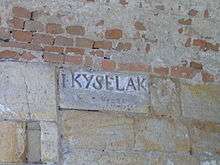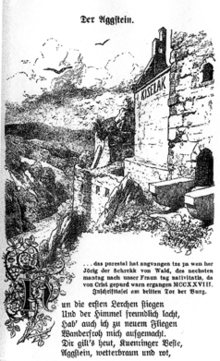Joseph Kyselak

Joseph, also Josef Kyselak (22 December 1799 – 17 September 1831) was an Austrian mountaineer and travel writer. He became famous for his habit to tag his name onto prominent places during his hikes across the Austrian Empire.
Life
The son of a family of civil servants, Kyselak was born in Vienna, where he attended the Piarist Gymnasium in the Josefstadt district. After he took his Matura degree, he worked as a fiscal, from 1825 in the rank of an assessor.
Allegedly as a wager, Kyselak began to write his name onto numerous places in the Habsburg lands and beyond. In 1829 he published a comprehensive account of a 1825 travel through Austria, Styria, Carinthia, Berchtesgaden, Tyrol, and Bavaria to Vienna, describing the engraving on Oberkapfenberg Castle. According to legend, he became so well known that Emperor Francis I of Austria ordered him to stop tagging public buildings and Kyselak promised to comply. The emperor found Kyselak's name carved into his desk following the audience.
Kyselak is even said to have climbed the peak of Mt. Chimborazo in Ecuador, where Alexander von Humboldt found his graffito in 1837. In fact, Humboldt visited the mountain already in 1802. Kyselak died as a victim of an 1831 cholera epidemic in Vienna.
Film
- Kyselak war da – Graffiti anno 1825
Legacy

Kyselak has been regarded as a predecessor of contemporary tagging and popular culture expressions, such as Kilroy was here or Peter-Ernst Eiffe. Numerous Kyselak graffiti are preserved, however often imitations.
His habit earned him an entry in Constantin von Wurzbach's Biographisches Lexikon des Kaiserthums Oesterreich (Biographical dictionary of the Austrian Empire, 1856–91). Kyselak is also mentioned in Joseph Victor von Scheffel's poem Der Aggstein (1863).
External links
| Wikimedia Commons has media related to Joseph Kyselak. |
- M. Mitchell - about Kyselak
- The Kyselak Project
- Joseph Kyselak, his book and a short video documentary is on display in the Museum of Austrian Literature
